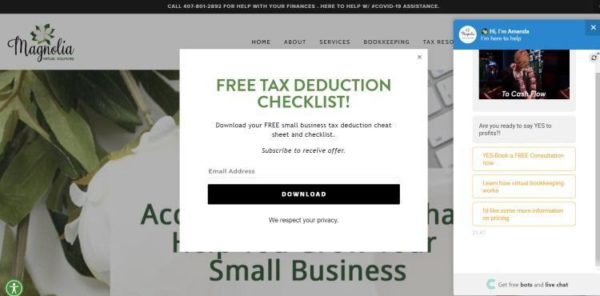
Virtual assistants are growing in popularity, with some studies indicating that they save businesses up to 78% on operating costs every year. Studies also show that virtual assistants are more productive and less stressed than office workers, thanks to their ability to perform work tasks remotely.
As more companies hire virtual assistants, being able to create an effective website for your service is becoming more important than ever. Virtual assistants are independent contractors, after all, and you need to show how your skills and expertise can benefit clients in order to let your business thrive.
In this article, we’ll go over the features each virtual assistant website should have and offer prime examples you can model your own site on.
What every great virtual assistant website needs to have
The goal of every great business website is to attract new clients. As such, virtual assistant websites need to not only list the types of services they offer, but also show how each service benefits clients.
Important information
Keep in mind that, although the demand for virtual assistants is growing, not all companies know how to work with remote freelancers. To help them, you’ll need to provide important information on your website, including:
- Your services. Virtual assistants provide many services, from bookkeeping to social media management. Make your specific services clear on your homepage so clients know you’re the right assistant for them.
- How you can help a business grow. Closely related, every virtual assistant should help a business run more smoothly. Show how each of your services will benefit a company’s operations and make its workload easier to manage.
- How you can be contacted. Communication is vital for freelancers to work effectively with their employers. Offer an easy way to contact you. Many virtual assistants provide an email address and phone number along with a “Contact Me” form on their website.
- How you work. Different assistants have different ways of completing tasks. Offer an easy-to-follow procedure for how your services work. Indicate how much time you need for specific tasks, how you communicate, and how your employers can provide feedback.
- Your rates. As a freelancer, you set the pay rates for your services. These rates need to be clearly communicated on your website. If you charge different fees for different services, that should be clear as well.
- Testimonials. Businesses feel more comfortable working with freelancers who have a proven track record. Offer written testimonials from satisfied clients who can share how easy it was to work with you.
Proof of professionalism
To complement the list of services, your website’s design should reflect the professionalism clients expect from a virtual assistant. Showcase this by making sure your site offers:
- A powerful foundation. Many businesses now expect professionals to use WordPress as the platform for their business websites. WordPress is free and easy to use. It can be modified to include new pages, and it has many plug-ins that can display your information in an attractive way.
- Good web hosting. A web host provides the technology and services that let a website be accessed on the internet.
- An attractive theme. A theme determines your website’s overall look, including its color scheme, layout, and style elements.
- A simple logo. Many virtual assistant websites simply use the assistant’s or business’s name in an attractive font as a logo.
- Good security. Make sure your website has an SSL (Secure Sockets Layer) certificate that shows your website’s URL is “https” and not just “http.” This added security demonstrates your professionalism and encourages others to share their information when contacting you.
- Easy navigation. Make sure all the pages of your website are clearly labeled and contain links making it easy for visitors to get from one section to another.
- A mobile-friendly design. More and more people use smartphones and tablets to find websites. It’s important you use a theme that’s mobile-responsive in order to look good on such devices.
Websites are constant works in progress, so even after you finish building yours, you should make sure to regularly update your content. Add new testimonials from other satisfied clients, show additional examples of your work, and consider adding a blog to better promote your services.
By making regular improvements, you’ll help your website evolve into a better online marketing tool for your business.
Great virtual assistant website examples
The following examples come from virtual assistants in a wide variety of fields. Each one, however, provides the information and features all clients expect from a professional. Spend some time studying each one and see how you can adapt its style to your own website.
Afterwords Communications

This website for a development editor and ghostwriter is easy to explore, thanks to the website navigation bar at the top of the homepage. It also uses plenty of white space to make text easy to read.
The homepage lists the business’s current clients and offers a free email newsletter of resources for writers and entrepreneurs (in exchange for contact information). Every link is designed to guide visitors toward becoming future clients.
Magnolia Virtual Solutions

This virtual assistant accounting service website immediately offers a chat box for instant communication. It also offers a free consultation, pricing information, and a list of bookkeeping services. Homepage sections include offers for free tax tips, deductions, and financial resources, encouraging visitors to keep scrolling.
Stephanie Mead Creative

This social media management website leads with the headline, “How Digital Marketing Can Help Your Business,” allowing the virtual assistant to highlight the benefits of using her services. Communication links include options for setting up a phone call or sending an email. Every single one of her services is clearly described, along with her rates, and she also has a link to her blog that offers helpful articles on social media management.
Tara Bosler, Creative Copywriter

This website advertises the virtual assistant’s expertise in email marketing and offers easy-to-follow links that direct visitors to her portfolio, testimonial, and contact pages. There’s also a “Work With Me” link that immediately lists what she can offer — website pages, blog posts, email campaigns — and spotlights how she can save her clients the burden of having to write such hard-to-create copy.
Success Beyond the Lens

This virtual assistant provides business management and marketing services for small business owners and a niche market: photographers. Her website reflects this by highlighting operations management packages for busy photographers. She also provides a series of podcasts with tips for successful photography and choosing a virtual assistant.
Creating your virtual assistant website
Studying excellent virtual assistant websites is an important part of making sure your own site has all the needed features to market you as a professional. Learning how to market your business online also provides you with an edge in the growing virtual assistant field.
To learn how to make sense of online marketing for your business, check out Constant Contact’s free marketing guide, The Download for professional services and industry specific blog articles. Utilizing these expert resources can help you build the virtual assistant website you need to gain the clients you want.




